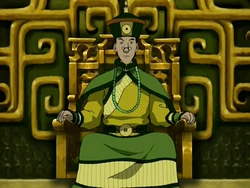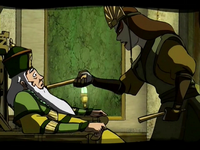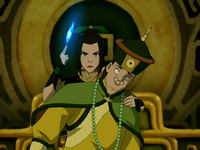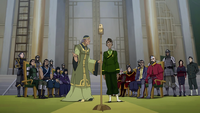- This article is about the political position. For other similar uses, see Earth King (disambiguation).
| "His Majesty is an icon, a god to his people." |
| — Long Feng to Team Avatar.[1] |

Kuei reigned as the 52nd Earth King.
The Earth Monarch[2] (styled Earth King if male and Earth Queen if female) is the ruler of the Earth Kingdom.[3] The full title of the Earth Monarch is "Monarch of All the Earth Lands and Glorious Defender of Ba Sing Se".[4] They are traditionally based in the capital city of Ba Sing Se, where the royal palace constitutes its own district within the Upper Ring of the city, functioning as both the monarch's residence and seat of government.[1] An Earth Monarch traditionally rules the constituent states of the kingdom, but individual regions also have their own local governments.[2] As of 174 AG, with the coronation of Wu of the Hou-Ting dynasty, there have been fifty-four monarchs of the Earth Kingdom. However, after Kuvira attacked Republic City, hoping to subsume it into her self-proclaimed "Earth Empire", King Wu decided to abdicate the throne and abolish the monarchy altogether, in favor of independent states with elected governments. This was akin to the democratic political system of the United Republic of Nations, and a motion for which Wu received the support of Avatar Korra.[5]
Traditionally, the Earth Monarch leaves behind all personal possessions upon ascending the throne, including their given name, and is henceforth known only as "Your Majesty" or by their reign number, enhancing their status as detached and sacrosanct individuals.[6] However, this was not a universal standard, since Earth Kings Kuei and Wu preferred their given names over their title, allowing even commoners to address them by it.[7][8] The Earth Monarchs are also worshiped as gods by some Earth Kingdom citizens, even though their political role has historically alternated between a largely symbolic figurehead and that of an actual royal ruler.[1][6]
The relation between the monarch and the general population has likewise varied over time: some rulers like Earth King Kuei had a populist style of rule,[7] while others like his daughter Hou-Ting insisted on their sacrosanct status, caring only about their own power and not their subjects.[9] Such authoritarian styles of rule resulted in rebellion and anarchy at least twice in the Earth Kingdom's history.[10][11]
History[]
Early history[]
The Earth Kingdom was gradually unified by the rulers of the city state of Ba Sing Se, and eventually one sovereign completed the unification wars and crowned themselves the first Earth Monarch. From then on, the Earth Monarchs would govern the Earth Kingdom from Ba Sing Se, usually never leaving the vast capital from their ascension until their deaths.[12] As a result, the Earth Monarchs often held absolute power in Ba Sing Se, using a loyal bureaucracy to carry out their will.[13]
The situation remained more complex outside the capital. The Earth Kingdom was too large to be successfully governed by a centralized government, and the Earth Monarchs consequently left some local rulers like the Monarchs of Omashu in power as long as they stayed loyal. In many regions, governors appointed by the Earth Monarchs likewise enjoyed great autonomy.[14] Regardless, many early Earth Monarchs were immensely powerful, attempted to exert as much influence on their empire as possible, and controlled their lands personally and even brutally.[6][11][13] The first Earth Monarchs were described as "proud warrior-kings".[6] They would use shirshu to cruelly execute their political enemies.[15] It was not unusual for early Earth Monarchs to violently eliminate their siblings due to them being potential rivals.[16] Several times in Earth Kingdom history, military commanders, ministers, and royal family members would attempt to overthrow the ruling Earth Monarch to take power for themselves; some succeeded, others were defeated.[17] An early line of Earth Monarchs was the Hao dynasty.[18]
During the childhood of Avatar Yangchen, the young Earth King Feishan had his reign contested by General Nong. They fought a prolonged war, and the Fire Nation and Water Tribes conspired to financially support Nong, though Feishan ultimately won the war. This diplomatic blunder became known as the Platinum Affair, and led to all three nations pursuing isolationist policies. Feishan was one of the few rulers to truly care about his poorest subjects, and was one of the more competent Earth Monarchs in history, but threatened to do terrible things to the four nations if he found that his authority had been undermined. Fearing what the mercurial Earth King would do if he learned of the shang merchants violating their charters, the shangs plotted to break free of his authority with the Unanimity project, but failed, with Yangchen apprehending all people involved. She informed the Earth King that the incident had been spiritual rather than a political conspiracy, and was granted administration of Bin-Er by the king when she promised she could both help the people and increase royal revenue by leaning on the advice of Avatar Szeto.[17][19][20]
By the 4th century BG, the position of Earth Monarch was hotly contested among the then-ruling royal family. The princes would try to kill each other in shadowy conflicts to rise to first-in-line to become the next Earth King, resulting in the Wars of Secrets and Daggers.[21]
Constitutional change and decline of the monarchy[]

Avatar Kyoshi threatened the 46th Earth King until he accepted a new constitution in order to quell the Peasant Uprising in Ba Sing Se.
The Earth Kingdom's political situation began to change under the rule of the 46th Earth King. He tried to change the Earth Kingdom into a centralist empire, taking advantage of the massive civil unrest in his kingdom. To achieve this goal, he used violence and oppression, causing a civil war and a peasant uprising in the process.[11][22] Due to these events and the intervention of Avatar Kyoshi, the Earth Kingdom was transformed into a constitutional monarchy to prevent future monarchs from abusing their power. This caused a dramatic change in the politics of the Earth Kingdom, and over time bureaucrats and local rulers used the new constitution to gather more and more power. In the process, the monarchy became stagnant and corrupt, as kings ceded or were forced to cede more and more control over the day-to-day operations to the governments and bureaucracy that sprang up around them. They traditionally made use of sixty-seven different seals, depending on the document in question.[6]
An exception to the decline of the monarchy was the exceedingly calculating Earth King Jialun, who was ruling soon after Kyoshi's death. He feigned incompetence, and was considered harmless by many of his contemporaries, but he was in fact manipulating everything in the system to his own benefit. Jialun reversed the genuine progress that Kyoshi had made by purging the sages who upheld her policies in the Night of Silenced Sages, after they spoke against the king's changes to the constitution drafted by Kyoshi and the 46th Earth King.[23][24] The Earth Kingdom soon became extremely corrupt once more, with many suffering due to policies enact to enrich the greedy Earth King, all from an appearance of weakness.[24]
However, Jialun's successors did not possess his extreme cunning, and while the government remained corrupt, the monarchs lost more power. At some point, the 51st Earth King came to the throne, only to later die, leaving his four-year old son Prince Kuei as the next Earth Monarch.

Due to 52nd Earth King Kuei's premature ascendancy to the throne, the position finally declined to that of a figurehead who lived a lavish lifestyle surrounded by courtesans and sycophants,[6] allowing Grand Secretariat Long Feng, Kuei's regent and later adviser, to take control of the capital Ba Sing Se.[1] In the spring of 100 AG, the traditional rule of the Earth Kings ended when the Fire Nation Princess Azula, assisted by the Dai Li, usurped the throne in a violent coup. The rightful Earth King Kuei was then forced into exile. When the Fire Nation took control over the city by Azula's order, the usurper left a Joo Dee as a puppet ruler with the title of "Supreme Bureaucratic Administrator of Ba Sing Se".[25]
After the end of the century long war, Earth King Kuei was restored on his rightful place as the leader of the Earth Kingdom. As such, he played a very important role in the execution of the Harmony Restoration Movement in order to remove the Fire Nation presence in the Earth Kingdom by transferring the Fire Nation colonials back to the Fire Nation. Kuei also reformed the Earth Kingdom government back to its original form so the monarch had full power over the government.[26]
Collapse[]

With the unrest in the Earth Kingdom nearly entirely settled down, Wu was crowned as the fifty-fourth king of all the earth lands.
Eventually, Kuei's daughter, Hou-Ting, succeeded her father as ruler of the Earth Kingdom and allowed the Dai Li back into the capital as a force working for her. During her reign, she spent large amounts of money on personal interests and tried to exert further control over the outer provinces of the Earth Kingdom, making her somewhat unpopular with her people.[9] However, Hou-Ting was eventually killed by Zaheer in 171 AG[10] and the throne remained vacant for three years, due to the fragmentation and widespread chaos that occurred in the Earth Kingdom following her death. Prince Wu, Hou-Ting's great-nephew, was the next in line to succeed her, though due to the instability in the kingdom, he was forced to flee the nation and seek refuge in Republic City.[27] He lived in the United Republic of Nations' capital for three years before being crowned the new Earth King in 174 AG. However, during his coronation, Kuvira denounced his authority and usurped power for herself, renaming the Earth Kingdom the "Earth Empire".[4]
Wu became the target of kidnappings, but he managed to stay out of harm's way and grew into his role as a leader of the people. He slowly gained the trust and faith of the people by taking the lead on the evacuation of Republic City when Kuvira attacked, helping to keep the refugees safe. After Kuvira was defeated, however, Wu made plans to step down as king and abolish the monarchy in favor of independent states with elected governments, akin to the political system of the United Republic of Nations, a motion for which he received the support of Avatar Korra.[5] The democratic movement materialized three months later with the first democratic elections in the State of Gaoling; however, the kingdom threatened to fall into chaos once more after Commander Guan of the Earth Empire brainwashed the state's citizens en masse, leading to his election as governor. Following Guan's surrender, Wu announced that the elections would be rescheduled, with each state determining its own election timetable. He reaffirmed his commitment to democracy, but promised to serve as the nation's strong and compassionate king until the democratic transition was complete.[28]
Known Earth Monarchs[]
Include all rulers titled 'Earth King' or 'Earth Queen'.
- 22nd Earth King - His rule marked the last time the Fire Navy was allowed to fly military colors in the Eastern Sea until the restriction was lifted in 296 BG.[14]
- Earth King Zhoulai - c. 8th/7th century BG, a close companion of an Avatar; lived three centuries before Avatar Yangchen's childhood.[29]
- Earth King Feishan - c. 5th/4th century BG, ruled during the adolescence of Avatar Yangchen.[20]
- 40th Earth King - c. 4th century BG, he was assassinated by Tieguai the Immortal.[30]
- Yi Ming - Unknown, some time between 295[31] and 270 BG[11]
- 46th Earth King - c. 270 BG
- Jialun - came to the throne before 66 BG; reign ended after 54 BG[24]
- 52nd Earth King, Kuei - Unknown - 100 AG; 100 AG - Unknown
- Azula[nb 1] - Spring 100 AG
- 53rd Earth Queen, Hou-Ting - Unknown - 171 AG
- 54th Earth King, Wu - 174 AG - Present, though moving to abolish the monarchy and split the kingdom into independent states with democratically-elected leaders.
Known Earth Kingdom regents and non-royal leaders[]
As a largely decentralised nation, the traditional rule of many Earth Monarchs has been questioned and eclipsed by various figures and individuals. This list includes regents, and de facto leaders.
- Jianzhu - Unknown - 296 BG, powerful Earth Sage, controlled most of the Earth Kingdom through a large network of allies at the peak of his influence.
- Long Feng - Unknown - 100 AG, Grand Secretariat of Ba Sing Se, leader of the Dai Li, and the 52nd Earth King's regent. Even after Kuei became an adult, Long Feng still held complete control over the Earth Kingdom government.
- Kuvira - 171 - 174 AG, Interim President of the Earth Kingdom and later leader of the Earth Empire.
Trivia[]
- The Earth Monarchs often wear clothing in bright shades of yellow. In Imperial China - one of the major inspirations for the Earth Kingdom - yellow was a color reserved solely for the Emperor and was often associated with the element of Earth.
- In addition, the clothing worn by Kuei and 46th Earth King is based on the chaofu, a traditional robe worn by Manchu emperors of the Qing dynasty, whilst Queen Hou-Ting's is more similar to a Guangxu period (1875 - 1908) qipao.
- In general, the Earth Monarchs have many parallels to Chinese emperors, theoretically all-powerful, enshrined rulers, though in many instances controlled by servants and the bureaucracy around them. Also, the Earth Monarchs Kuei and Hou-Ting mirror real-life Chinese royals, Kuei resembling the Xuantong Emperor and Hou-Ting bearing similarities to Empress Dowager Cixi.
- On the wanted posters of Team Avatar issued by Hou-Ting, the "Earth Queen" title is written in Chinese as 土國皇后, which literally means "The Empress of the Earth Kingdom".[32]
- No Earth Monarch had been to the Outer Wall of Ba Sing Se until Kuei ventured there with Team Avatar.[33]
- Some Earth Kings were known to have multiple wives.[34] This marks the only recorded instance of polygamy in the world of Avatar.
- Several Earth Monarchs used doubles to protect themselves from assassins. The Earth King who ruled in 295 BG was noted for his particularly large number of decoys.[35]
Notes[]
- ↑ Avatar Extras for "The Crossroads of Destiny" on Nicktoons Network refers to Azula as "Earth Queen Azula", meaning that she reigned in the nation as ruler beginning from Long Feng's second incarceration and likely until she left Ba Sing Se. However, Azula was never officially crowned, and thus she can only be considered as a usurper.